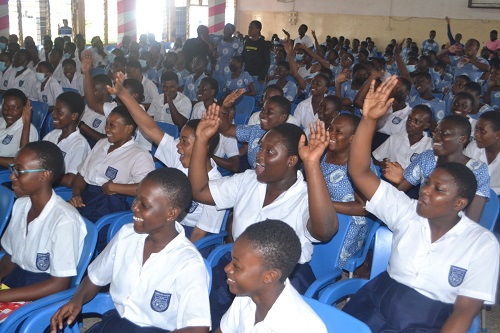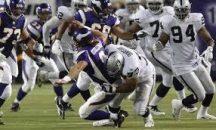Labone Secondary School: a brief history

A section of Labone Senior High School students Photo: Lizzy Okai
The genesis of Labone Secondary School can be found in the students and teachers who left the Christine Smith Institute at Merry Villas, Asafoatse Nettey Road, Accra, in 1949 and founded the Labone College as it was then known.
Prominent among them were Rev. Matei Markwei, Principal, Mr Alpheus Kofi Ansah Johnson, Assistant Principal, Mr Joseph Andoh Kesson and Mr John Spencer Bilson.
The college was started in January 1949 in a cluster of buildings belonging to Messrs Armah, Okpoto, Osofo Ashalley and Anang of KlannaAbormi. These housed the dormitories, dining hall and Science Laboratory.
During Mid-March, 1949, a catastrophe hit the school. Fire engulfed the school destroying the personal effects of the students. Both the dormitory and laboratory were totally burnt down. Fortunately there were no loss of lives as the boarders had left for the Presbyterian School (Salem) for games.
The school authorities were finding it difficult to pay the salaries of teachers and it became increasingly difficult to sustain good academic work. Eventually a two-storey building was secured at Teshie. Girls were for the first time admitted into the school.
In the latter part of 1950, other teething problems began to show up at Teshie. These problems were scarcity of water, the distance from the school to Accra and Osu, transport problems and bus fares payable by the day students to and from the school. This resulted in a fall in the numerical strength of the students.
To arrest the situation from getting worse, the authorities started looking for a place to move the school again. Rent arrears which had been a perennial problem reached its zenith. Rent arrears at $300 and Ataa Boi, the landlord, ejected the school from his premises.
Through the help of Mr Okwei Mensah and Mr W.K. Ollenu and others, another accommodation was secured at Tenashie now popularly known as ‘Ako Adjei’. It was the new building of Mr D.A.K. Sowah, a private businessman.
In 1951 the school moved to the premises of Mr D.A.K Sowah. It was during this stage that the school experienced a new lease of life. The school came under a newly formed Educational Unit (formed by Dr Nkrumah to cater for all schools and colleges in the country).
On November 10, 1951, the school was formally inaugurated and it operated under a new name —Ghana College Christianborg. In 1952, Mr Joseph Andor Kesson, one of the Co-founders left the school leaving Mr A.K.A. Johnson, the Headmaster as the only surviving co-founder in the school.
The financial problems which had plagued the school previously could still not be overcome. Money raised through student’s school fees could not pay salaries of staff and rent could also not be paid regularly. The school would have collapsed but for the magnanimity of the landlord, Mr. D.A.K. Sowah. And by the end of 1955 the school owed him rent totalling $1,600.
Meanwhile, the Ghana Education Trust had been founded by Dr Nkrumah and since it was the desire of Mr Sowah that the school should come under its umbrella to enable it gain government assistance, he continued to be patient with the school.
It must be mentioned here that one personality who also stood tall in getting the school to stand on its feet was Mr Ako Adjei, the then Minister of Labour and Co-operatives. Mr Ako Adjei together with Mr Sowah and the headmaster fought for government recognition. One of the conditions for government recognition or encouragement as it was then known was that the school should be headed by a graduate.
On November 15, 1955, Rev. Samuel Gyasi Nimako, holder of Bachelor of Arts and Divinity degrees was appointed Principal. The name of the college thereafter was changed to Ghana Secondary School, Labadi.
On August 23, 1956, Mr D.A.K. Sowah wrote to the Director of Education, Accra, informing him that he had waived the amount of $1,660 areas of rent owed him by the school and that he would not then or in future claim the said amount or any part of it from the school.
This singular gesture of altruism went a long way to enable the school gain government recognition. Government encouragement was granted in October 1956 and with effect from July 1, 1956. The name of the school was then changed to Labone Secondary School.
Having attracted government recognition, the Board then set themselves the task of finding a permanent site with permanent buildings for the school. The present site on which the school now stands was originally negotiated for by Mr D.A.K Sowah for his private use from the Lands Department.
However, the then Minister of Education supported by the Board having convinced Mr Sowah that the school would in future be elevated to university status which in turn would be a great honour to the citizens of La, consented to forgo all expenses he had incurred in connection with the land and gave it to the school.
The Ghana Educational Trust (GET) built a new compound for the school incidentally on La soil where 10 years ago the school had started. After 10 years of struggle and trial, the ship had finally found a safe berth home. Labone Secondary School has a permanent compound at La-Accra. In January 1960 the school moved to its present and permanent site.
Rev. S.G. Nimako, the Headmaster at that time was assisted by Mr Richard Lomo Jones. Through academic achievements as well as
sports the school quickly became famous. Mr Jones succeeded Rev. Nimako in February 1961. The school population at the time stood at 401 (292 boys and 109 girls).
In September 1961, Sixth Form Education was introduced into the school, an index to the school’s academic performance. From this time on the school was recognised and acknowledged as one of the best schools in the country and LABOSCO became a house hold word.
Mr Jones retired in 1968 and was succeeded by Mr Ebenezer Alexander Lamptey. Mr Lamptey was followed by Mr Bossman Owusu-Ayim in 1982. The period coincided with a tremendous growth in the number of students reaching an all-time high figure of 2,500 in 1989. This increase was in no small way filliped by the government’s policy of de-boardinisation in 1984.
From 1986 to 1996 only sixth formers stayed in the boarding house. The number of students was pruned down to about 1,600 – a deliberate school policy, by the headmaster, Mr Peter Owusu-Donkor (who had replaced Mr Owusu-Ayim in 1990) in order not to overstretch the school facilities and resources.
Mr Owusu-Donkor was followed by Mrs Cecilia Aggrey-Mensah, incidentally the first female head of the school. The current head, Mrs Joyce Ossei-Agyekum took over from Mrs Aggrey-Mensah in September 2003.
The school presently has a population of 1,700 offering programmes in Business Studies, Home Economics, Visual Arts, General Arts and General Science.
This succinctly is the history of La Bone Secondary School. The school can boast of former students in all spheres of life. From the political, professional, business to the academics. From small beginnings it has now come to take its rightful place as one of the best secondary schools in the country.













